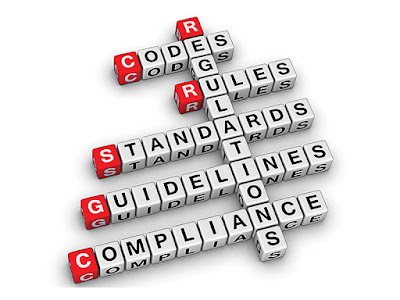The National Fire Protection Association(NFPA) addresses more than just fire and electrical hazards. They also address security. Security is addressed in two primary documents, NFPA 730, Guide for Premises Security, and NFPA 731, Standard for the Installation of Premises Security Systems. Crime prevention through environmental design (CPTED) and the practical application of CPTED principles are addressed in NFPA 730. Crime Prevention Through Environmental Design is the concept of crime prevention and neighborhood safety accomplished through natural elements and structural design. CPTED utilizes four strategies that contribute to “the proper design and effective use of the built environment that can lead to a reduction in the fear and incidence of crime and an improvement in the quality of life” within a community. The CPTED strategies are natural surveillance, natural access control,territorial reinforcement, and maintenance.
How is this addressed in NFPA 730?
Chapter 8 of NFPA 730 is entitled, “Crime Prevention Through Environmental Design”. It provides some general requirements for the application of CPTED principles and states that these principles should be applied when specifically referenced in the occupancy specific sections of the document. This chapter, and the specific occupancy types, divide CPTED requirements into the following sections:
Crime and loss prevention
Human behavior
Lighting
Landscaping
Aesthetics
There are seven specific occupancy types and chapters that contain CPTED requirements and reference back to Chapter 8.
Educational Facilities, Colleges, and Universities (Ch. 11)
Lodging (Ch. 14)
Multi-Dwelling Unit Buildings (Ch. 15)
Restaurants (Ch. 16)
Shopping Centers (Ch. 17)
Retail Establishments (Ch. 18)
Office Buildings (Ch. 19)
These chapters each contain a varied amount of CPTED guidance. Some just refer back to Chapter 8, others have more specific guidance. A common requirement in all is the requirements for adequate and effective lighting.
CPTED for Educational Facilities
Human behavior, lighting, and landscape elements are addressed for CPTED in educational facilities, colleges, and universities. Human behavior can be addressed by having a code of conduct that clearly describes the expectations, regulations, and enforcement for infractions.
Lighting should be adequate and clearly illuminate corridors, stairwells, and elevators. Lighting of exterior areas and parking lots is important, as well.
Landscaping should be trimmed and well maintained. The CPTED “2’-6’ rule” for landscaping recommends that plants be no more than 2’ high and tree canopies to be no lower than 6’. Annex information in NFPA 730 allows plants to be 36” high and tree canopies trimmed up to 7’ high.
CPTED for Residential Buildings
There are two types of residential properties addressed in NFPA 730, lodging and multi-dwelling units. Lodging facilities are those properties that provide housing on a transient basis, such as hotels and resorts. Multi-dwelling units are buildings that contain more than three living units.
Priority for these occupancies is on crime and loss prevention and lighting. Crime and loss prevention starts with research and assessment of historical crime data in the area. From this research and data a plan can be implemented to prevent further occurrences on the property. Another key component of crime and loss prevention is frequent and open interaction with law enforcement and the community.
Lighting should be adequate and clearly illuminate corridors, stairwells, elevators, and access routes to common areas. Light switches in common areas should be tamper proof or controlled remotely.
CPTED for Restaurants
Crime and loss prevention, lighting, and aesthetics are essential components for crime prevention in restaurants. Crime and loss prevention can be accomplished by keeping as little cash as possible available and on hand. Though not traditional CPTED elements, NFPA 730 also recommends the use of electronic security applications such as safes, intrusion detection systems, and physical security devices.
Lighting must be adequate and efficient. The celebrated entrance and interior should be well lit. Also, the public parking lot and surrounding outside areas should be lit to prevent crime incidents outside of the establishment.
Aesthetic components should not be installed in a way that would block visibility from the street to inside of the building. Signs, posters, and product displays should not obscure windows.
CPTED for Retail
Crime prevention methods for shopping centers and retail environments are comprised of crime and loss prevention, lighting, landscaping, and aesthetics. Each of these components are similar to methods previously discussed for similar occupancy types.
Crime and loss prevention can be accomplished by keeping as little cash as possible available and on hand, and through the use of electronic security applications such as safes, intrusion detection systems, and physical security devices. After hours, cash should be secured in a safe or vault.
Lighting must be adequate and efficient. The celebrated entrance and interior should be well lit. Also, the public parking lot and surrounding outside areas should be lit to prevent crime incidents outside of the establishment.
Landscaping should be trimmed and well maintained. The CPTED “2’-6’ rule” for landscaping recommends that plants be no more than 2’ high and tree canopies to be no lower than 6’. Thorny bushes or briars, and thick patches of shrubbery can be used as an intrusion deterrent.
Aesthetic components should not be installed in a way that would block visibility from the street to inside of the building. Signs, posters, and product displays should not obscure windows.
CPTED for Offices
The only recommendation for crime prevention for office buildings offered by NFPA 730 is lighting. Lighting must be adequate and efficient. Corridors, stairwells, and elevators should be well lighted. Lighting of exterior areas and parking lots is important, as well.
NFPA 730 does not provide conclusive or exhaustive CPTED guidance. Using the guidelines and annex information within the document does start architects, designers, and security professionals down the right path for premises protection, security, and life safety.
For more information check out resources from The US CPTED Association.







